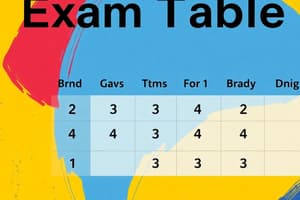Podcast
Questions and Answers
What factors must be considered when developing a class timetable?
What factors must be considered when developing a class timetable?
The availability of rooms, teachers, and students' other schedules must be considered.
How does the complexity of timetable development increase with more parameters?
How does the complexity of timetable development increase with more parameters?
As more parameters like teacher preferences for rooms and multiple course assignments are added, the scheduling becomes increasingly complicated.
What is the primary role of a doctor when diagnosing a patient's illness?
What is the primary role of a doctor when diagnosing a patient's illness?
A doctor collects patient information and measurements to make a diagnosis based on their prior knowledge.
What importance does intelligence play in scheduling classes?
What importance does intelligence play in scheduling classes?
What initial steps does a doctor take when a patient reports feeling unwell?
What initial steps does a doctor take when a patient reports feeling unwell?
What do the operators 'H' and 'S' represent in the context of a solution space?
What do the operators 'H' and 'S' represent in the context of a solution space?
Explain what a solution space is in relation to problem-solving.
Explain what a solution space is in relation to problem-solving.
How can searching be described in the context of problem-solving?
How can searching be described in the context of problem-solving?
What is the significance of nodes and edges in graph representation of a solution space?
What is the significance of nodes and edges in graph representation of a solution space?
Why is understanding tree and graph terminology important in searching techniques?
Why is understanding tree and graph terminology important in searching techniques?
Flashcards are hidden until you start studying
Study Notes
Creating a Timetable
- Developing a timetable for a school or university can be very complex, especially when dealing with a large number of students and teachers.
- The process involves considering multiple factors such as teacher availability, room availability, and student schedules.
- The timetable needs to be carefully constructed to ensure all classes can be held within a fixed time frame.
Problem Solving using Search Algorithms
- The process of solving a problem can be represented by a search algorithm and can be viewed as a search for a goal state starting from an initial state.
- This search is carried out through a "solution space" which is a representation of all the possible states and moves.
- The search can be viewed as moving through this solution space using "operators" which are actions that transform the current state into a new one.
Types of Search Algorithms
- Depth-First Search (DFS): Explores the tree by going as deep as possible along a branch before backtracking to explore other branches.
- Advantages: Small space requirements.
- Disadvantages: Can run infinitely in search spaces with infinite paths, does not guarantee the shortest path.
- Breadth-First Search (BFS): Explores the tree by going through all nodes at a particular level before moving to the next level.
- Advantages: Guarantees finding the shallowest path.
- Disadvantages: High space requirements.
Progressive Deepening
- This technique improves upon both DFS and BFS by combining the advantages of both.
- It works by performing DFS to a specific depth, increasing the depth incrementally until the goal state is found.
- It achieves BFS-like behavior while conserving space.
Hill Climbing
- An "informed search" technique that uses a heuristic (an estimate) to guide the search towards the goal state.
- It moves towards a node that is believed to be closer to the goal state based on the heuristic.
- Hill climbing may not always find the optimal solution but is often efficient.
Beam Search
- Similar to hill climbing, but instead of exploring only the best node at each level, it explores a fixed number of the best nodes.
- This technique is suitable for problems with a large number of possible paths but is not guaranteed to find the optimal solution.
Branch and Bound
- This technique aims to find the optimal solution without resorting to exhaustive search.
- It builds a tree structure representing the search space and uses problem-specific information to prune branches that are unlikely to lead to the optimal solution.
- By eliminating less promising paths, branch and bound can significantly reduce the time required to find the optimal solution.
Studying That Suits You
Use AI to generate personalized quizzes and flashcards to suit your learning preferences.




